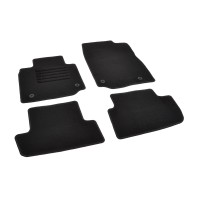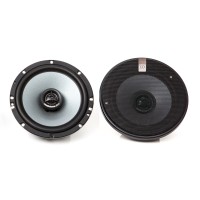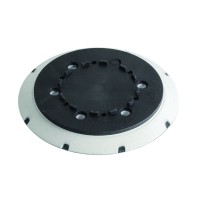Zapco ST-4B amplifier
More about the product
- Use our consulting room
- You can return the goods to us within 14 days
- Try the product at our store
Zapco ST-4B amplifier
Zapco has a reputation for unsurpassed sound reproduction quality and high reliability. It is a dedication to sonic clarity and a passion for performance that has built Zapco's reputation. Not a single newly introduced Zapco amplifier has ever posed any threat to the company's position as a manufacturer of premium amplifiers and processors. However, not everyone needs an audiophile amplifier either for competitions or for personal use. So the question arose whether Zapco could use 40 years of audio experience and develop an amplifier for everyday use. An amp that everyone can afford, but that stays true to Zapco's heritage of sound and reliability. And the answer is definitely yes! With the new ST-B (Studio-B) amplifiers, Zapco brings high sound quality that everyone can now afford.
The main features of the Zapco ST-4B amplifier
- 4-channel class AB amplifier
- Stable up to 2 Ω, in the bridge up to 4 Ω
- Power MOSFET
- RCA and OEM high-level inputs
- Continuous input power control
- FULL / LP / HP electronic crossover
- Bass Boost
Important features of Zapco Studio-B amplifiers
While sound quality is always Zapco's number one factor, there are other factors in the Studio Series amps that make them amps for everyday use. The aluminum chassis is more compact and lighter to make the range easier to fit into today's smaller cars or tight spaces. The amplifiers have the versatility and rich equipment that you are used to in higher model ranges. Crossovers are a matter of course, with a monoblock also a subsonic filter or phase rotation, and there are also RCA outputs for easy connection between amplifiers. ST-B amplifiers are not intended for competition, they are designed for everyday use in your car. So put on your favorite music, turn the volume control and you'll see that dedication to sonic clarity is definitely a good thing.About Zapco Amplifiers
Zapco is the oldest high-end car audio brand in the world, specializing in high-end car amplifiers and DSP processors. The company was founded in the USA back in 1974 and has been collecting one award after another since then. And this both from prestigious organizations that evaluate the quality of products and innovations, as well as at global competitions focused mainly on sound quality. Zapco amplifiers represent audiophile quality without compromise, defining the standard of quality and setting the criteria by which other products in the industry are judged. At Zapco, for over 45 years, they have been constantly looking for innovative ways to bring better sound to the automotive environment, and this relentless pursuit of absolute sound quality has always resulted in new technologies and high-end products. Are you asking why? Because nothing else can capture the soul and bring tears to the eyes like music. Music can make you dance for joy..... of all the arts, music has the most powerful and immediate effect on your body and mind. Reproducing music in all its beauty and delicacy deserves nothing less than the best efforts of all Zapco employees. And also because music matters!
| Catalog number | ST-4B |
| Brand | Zapco |
| Links | Official web presentation (English) |
| Number of amplifier channelsAmplifiers are divided into: - Monoblocks - 2-channel - 3-channel - 4-channel - 5-channel - 6-channel - multi-channel Each channel is used to power one speaker for the coaxial type, or one side if they are component speakers. Monoblock type amplifiers are mainly used for subwoofers. 2-channel are suitable for both subwoofers and, for example, the front pair of speakers in a car. 3-channel is used for front or rear speakers + subwoofer. 4-channel are used for front + rear speakers or 1 pair of speakers + subwoofer. 6 or 5-channel are used for 2 pairs of speakers + subwoofer, most often. Bridging means connecting the amplifier to a bridge, using the + pole from one channel and the - pole from the other channel. In most cases this is shown as "BRIDGED" on the amplifier. | 4 |
| Energy class of the amplifierAmplifiers are divided into two basic classes: analog and digital . Analog amplifiers (A/B) have higher consumption requirements, but usually have a more natural sound. Digital amplifiers (D) have significantly lower consumption and higher efficiency, but the sound may not be as faithful as with classic analog amplifiers. | AB |
| RMS power into 4 ΩRMS power when loading speakers or subwoofer at 4 Ω. RMS power is the constant power of the amplifier and is one of the most important parameters when choosing an amplifier. | 4 x 65 / 2 x 180 W |
| RMS power into 2 ΩRMS power when loading speakers or subwoofer at 2 Ω. RMS power is the constant power of the amplifier and is one of the most important parameters when choosing an amplifier. | 4 x 90W |
| Low-pass filter (LPF)LPF / LP or "low pass filter" offers the possibility to adjust the amplifier using a potentiometer so that the lower band plays only the frequencies in a certain band that you need. This filter is used to adjust the frequency range for the subwoofer, so that it does not overload or distort the sound. Example: Amplifiers most often have an LPF from 20 to 300 Hz. We recommend setting this potentiometer in the range of 45-80 Hz. | 50 - 250 Hz |
| High pass filter (HPF)HPF / HP or The "hi pass filter" offers the option of setting the amplifier using a potentiometer so that medium, possibly mid-bass and treble frequencies play upwards from a certain frequency. Example: Amplifiers most often have an HPF from 40 to 300 Hz. If we set the potentiometer to a value of approx. 150 Hz, the sound will be clipped so that it plays frequencies from 150 Hz up to the maximum upper limit of the entire frequency range of the amplifier, perhaps up to 20,000 Hz. We recommend setting this potentiometer in the range of 80-160 Hz. Thanks to this setting option, the speakers can handle a higher performance, as you will not overload them with bass in the lower frequency range. | 80 - 3000 Hz |
| Frequency rangeThe ability of the amplifier to reproduce the signal from the lowest frequency to the highest = faithfully reproduce the sound in a specific frequency band. Professionally: In the frequency range from 40 to 16,000 Hz, the vast majority of fundamental and overtones (harmonics) of all musical instruments are found. We are interested in the course of the radiated sound pressure in this range of frequencies when the loudspeaker system is supplied with constant power. We call this course the frequency characteristic, which tells us the level of radiated sound pressure in decibels (dB) depending on the frequency. The frequency characteristic of a speaker or speaker system can be expressed most succinctly with a graph. Mostly, however, the frequency characteristic is indicated by indicating the maximum tolerance of the sound pressure in the given frequency range, e.g. 50 to 15,000 Hz -+ 6 dB. Since the frequency characteristics of loudspeakers and systems in general are quite uneven, some manufacturers do not even specify this maximum tolerance of sound pressure in decibels in their catalogs for reasons of prestige. Data impoverished in this way is unfortunately worthless. What is valid is that the manufacturer offers a speaker system with a frequency range of 30 to 20,000 Hz, if he is worried about stating the maximum unevenness of the sound pressure in this range, because he can have a tolerance of, for example, +- 20 dB. The unevenness or undulation of the frequency curve in good speaker systems for high-quality music performance should not exceed +-3 dB in the 80 to 12,000 Hz band and +-6 dB in the 40 to 16,000 Hz band. Greater unevenness already depletes or emphasizes certain tonal areas, which can cause audible or even disturbing distortion. The proportion between fundamental tones and higher harmonics also changes, thereby changing the color of the sound, and individual musical instruments as well as the entire musical image sound unnatural. | 20 - 20000 Hz |
| Harmonic Distortion (THD)Total harmonic distortion indicates how much the input signal is distorted in the amplifier. Distortions appear as overtones contained in the output signal. The proportion of originally absent parts of the signal is given as a percentage, typical values are between 0.001% and 0.5%. Distortion is measured in their power band. If it exceeds the limit of 0.7% from a certain power, it is the value of the output power of the given amplifier, from which it no longer plays without distortion and from which the distortion usually increases steeply, so that no further increase in power can be counted on. The lower the value, the better. | 0.2% |
| Signal-to-noise ratioThe signal-to-noise ratio means that the output signal always contains noise. The signal-to-noise ratio expresses how much of this noise is compared to the useful signal. The so-called A value is given, which does not take deep and very high frequencies into account. This corresponds to the characteristic of human hearing, which is not so sensitive to deep frequencies, especially below 1 kHz. The higher the value, the better the amplifier is. | 97 dB |
| Input sensitivityIn order for the amplifier to perform its function correctly, it requires an input signal of a certain level, which is different for car radios. It is measured in "Volts" (e.g. 2 V, 4 V, etc.) The higher the value at the output of the pre-amplifier, or car radio, the less demands are placed on the power of the amplifier. However, the amplifier must allow this input sensitivity, and for that reason this value is also given for the amplifier. | 0.25 - 5V |
| Bass boostBass boost or bass enhancement. With this function, the bass itself can be emphasized, at a high level of bass boost, the speakers and the subwoofer can distort a lot and the sound will be worse than better. We therefore recommend using the "bass boost" function wisely. With maximum use of bass boost, there is a risk of damage to the speakers and thus to the subwoofer. | 0 - 12 dB |
| High level inputsThe high-level input on the amplifier allows connection directly to the existing speakers in the car without additional purchase of an external high/low adapter. Important equipment in the case of installing an amplifier on an original car radio. | Yes |
| The value of the fuses on the amplifierFrom the value of the fuses on the amplifier, you can get a true picture of the real performance of the amplifier. | 1 x 40 A |
| Dimensions of the amplifier | 182 x 52 x 280 mm |





























